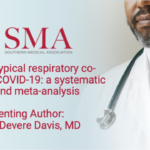Abstract | November 6, 2020
Viral and atypical respiratory co-infections in COVID-19: a systematic review and meta-analysis
Learning Objectives
- Upon completion of this lecture, learners should be better prepared to approach the patient positive for COVID-19.
- Learners should be able to describe the implications of co-infection to their patients diagnosed with COVID-19.
- Learners should consider the likelihood of co-pathogen infection and how this may alter diagnosis and treatment.
Background/Knowledge Gap: A novel coronavirus, now called SARS-CoV-2, was identified as the cause of pneumonia in a cluster of patients in Wuhan, China in December of 2019. Initially, experts including the Centers for Disease Control (CDC) and several state health departments recommended testing individuals with fever and lower respiratory tract infections for other viruses with instructions not to test for SARS-CoV-2 if alternate infections (eg, influenza) were present. More recently, experts have recommended that individuals who undergo testing for SARS-CoV-2 should additionally be tested for other common respiratory pathogens besides influenza. Respiratory co-infections have the potential to affect the diagnosis and treatment of COVID-19 patients. This meta-analysis was performed to analyze the prevalence of respiratory pathogens (viruses and atypical bacteria) in COVID-19 patients.
Methods/Design: This review was consistent with Preferred Reporting Items for Systematic reviews and Meta-Analyses (PRISMA). Searched databases included: PubMed, EMBASE, Web of Science, Google Scholar, and grey literature. Studies with a series of SARS-CoV-2-positive patients with additional respiratory pathogen testing were included. Independently, 2 authors extracted data and assessed quality of evidence across all studies using Cochrane’s Grading of Recommendations Assessment, Development and Evaluation (GRADE) methodology and within each study using the Newcastle Ottawa scale. Data extraction and quality assessment disagreements were settled by a third author. Pooled prevalence of co-infections was calculated using a random-effects model with univariate meta-regression performed to assess the effect of study subsets on heterogeneity. Publication bias was evaluated using funnel plot inspection, Begg’s correlation, and Egger’s test.
Results/Findings: Eighteen retrospective cohorts and 1 prospective study were included. Pooling of data (1880 subjects) showed an 11.6% (95% confidence interval [CI] = 6.9–17.4, I2 = 0.92) pooled prevalence of respiratory co-pathogens. Studies with 100% co-pathogen testing (1210 subjects) found a pooled prevalence of 16.8% (95% CI = 8.1–27.9, I2 = 0.95) and studies using serum antibody tests (488 subjects) found a pooled prevalence of 26.8% (95%, CI = 7.9–51.9, I2 = 0.97). Meta-regression found no moderators affecting heterogeneity.
Conclusions/Implications: These results indicate that co-infections with both respiratory viruses and atypical bacteria are a common and potentially important factor in patients with COVID-19. The majority of individuals within included studies were symptomatic and were admitted to the hospital. It is possible that co-infection rates are higher in these patients and co-infection contributed to symptoms, disease severity, and hospitalization. Co-infection with other respiratory pathogens has important implications for diagnosis and prognosis. It is possible that the clinical presentation, laboratory results, radiological findings, and outcome differ between SARS-CoV-2 positive patients with and without co-infections. Pooled prevalence was 16.8% in studies that tested 100% of patients for co-pathogens. These results indicate that clinicians should not rely on positive tests for these co-infections when considering whether or not to test patients for SARS-CoV-2. Further study is needed to determine if co-infections alter clinical features, laboratory and radiological examinations, and outcomes for patients with COVID-19.

